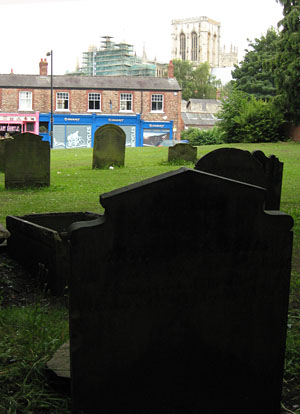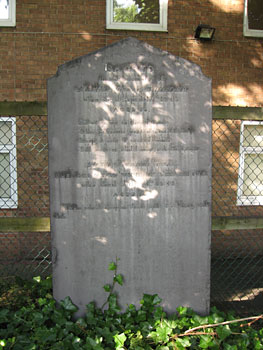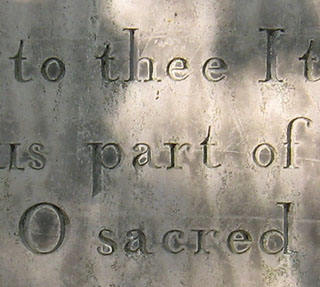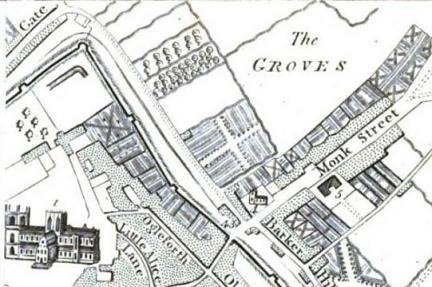One of the best things about compiling pages on this site is the way one thing leads to another, one local detail reminds me of another, things naturally link, and I can just wander off wherever the fancy takes me and the subject matter suggests.
So, ‘previously on York Stories’, we were standing on a patch of grass in front of the Bile Beans ad.
On that patch of grass was once a church, not long gone, demolished in the late 1960s. Gravestones remain to remind us of it, towards the back of that patch of grass, as most people passing have no doubt noticed. Just as there are gravestones in King’s Square, where once there was a church, and in an old churchyard in Bishophill, also now missing its church.

The three sites have their missing church in common, but not much else. King’s Square is all paved and functional and busy; St Mary’s churchyard is green, peaceful, feels ancient and special. The parishioners of St Maurice’s lie under neatly-mown grass in a rather ‘municipal’ environment, with a bit of shrubbery for company, next to busy roads and an unbeautiful 20th century building.
Walking onto their patch and looking back gives this much more pleasing view. They’re within sight of the Minster, and the city wall. That famous Bile Beans ad is just off to the right.
Here lie parishioners who presumably assumed that this ground would be forever sacred. Including the vicar, whose daughter died in 1854, aged six, ’suffer the little children to come unto me’ carved on her headstone.

Right against the boundary is a particularly large headstone, to Matthew Creaser, builder, lit beautifully by dappled sunlight through leaves. The beauty ends there, in the sunlight and stone. Right behind it is a functional wire fence and behind that an ugly municipal building. Around it, in the shrubbery, are piles of empty lager and cider cans from the street drinkers who have to hide in the shrubbery in case they offend the tourists.
I wonder what he would have thought of it all, this man who so carefully prepared for his end, for meeting his maker, and who planned a place for those he loved, in the certainty of their meeting later.

The inscription reads:
“Silent grave to thee I trust,
This precious part of mortal dust.
Keep it safe O sacred tomb
Till wife or child may ask for room.”
More information
The map at the top of the page is from Sotheran’s 1803 guide to York and shows the earlier St Maurice’s church. This small church had become ‘dilapidated’, according to an 1854 guide book. It was rebuilt in 1878. A photo in the archives of The Press shows this later church, which was demolished in 1969.






Enjoyed taking the’bile beans’via your column,
and wondered when the wall was first painted with same,as in my many WW2 visits to Lord Mayors Walk via Groves Lane,to my Saturday fruit and veg.shop job,at the corner shop,I don’t remember seeing it.I might have had my head down concentrating on my job,but it would be hard to miss.In those days the Church and its dark stone shell would have dominated the area,I always thought it was called St Wilfreds,being near the Nuns of that name nearby,and I was sent there on Sunday afternoons to ‘Sunday School’,a very frightening experience,to a non catholic boy,unused to the traditions,of that faith.The Nuns occupied the end seats ,ready to eliminate any unappropriate childish behaviour,and encourage due reverence.Not one of my best memories!
i knew that there were gravestones there, i guessed there was once a church.. but never expected such a confident, bold, dominating Victorian church as this… thankyou! i feel a little wiser.. [only a little ;-)
Thanks Stephen. It sounds like the Bile Beans ad was covered/partly covered with billboards for some years, which I guess is why it lasted so well, preserved from the elements.
It was a confident-looking church, you’re right Mallory – I bet they never imagined it would last less than a century before being pulled down.
I loved to roam round York cemetery as a child, my baby sister was buried there, her little grave marker removed sadly. tiny grave for a 6 months old child.
My grandparents too are there.
My parents we had cremated and scattered their ashes on the North York Moors which they loved to visit yearly.
I loved to roam the cemetery as a child, it was a peaceful and safe place in those days. Lovely old tombstones and inscriptions.’
I went to St. John’s College in the early 70s and was told that the organ in the new chapel had come from St. Maurice’s Church. Does anyone know if this is true?
Yes, that is apparently correct: a “Willis 1880 organ from St.Maurice, Lord Mayor’s Walk, York
transferred to West gallery of new College Chapel building” – see http://www.npor.org.uk/cgi-bin/Rsearch.cgi?Fn=Rsearch&rec_index=N03944 and also http://t.co/yJDl0fUmCx
With thanks to Robert Sharpe for the info.
I was one of the builders that re-used the stone from the demolition of the St. Maurice church to build a bungalow, in 1969; among the stones we discovered a ‘door knocker’ in the shape of a head with grapes instead of hair,made from cast iron; it looks like ‘Bacchus’ the god of wine? vineyards? of Roman mythology, my question would be, what age could this be? obviously, not Roman, but, which era is it from?? I do have a very good photo of it; would you be interested in viewing it?
Thanks for this interesting piece. My father’s family (Frankish) came from the St Maurice district (2 Vicars Row, according the 1871 census), so it’s likely that some of my ancestors lie in this churchyard.
Pingback: York St John – Short Ghost Stories | Ollie's Blog
What an absolute criminal shame. Why on earth was it demolished?
Imagine how much better that area would look, if the church remained still?
They really did some unforgivable things in the 60s and 70s.
This was the church where where my parents were married in 1949 and where I was baptised in 1952, and, whilst researching my family tree, I found that my 5x great grandparents had their son baptised here in 1813. G g g g g grandfather was a corn dealer, on Lord Mayors Walk.
Contributor’s comments interesting to me, as I was born in the Groves (1942). I was a chorister at St Maurice’s. The article about the organ from the church being re-installed elsewhere – our organist and choirmaster was a Mr Scott. Every year at Easter, we performed The Messiah or The crucifiction (Steiner). The Revd. Bulmer was in charge. Once a year we had a procession from St Maurice’s to Holy Trinity Goodramgate.
Stephen – 1st comment – the fruit & veg shop between the bottom of Lord Mayor’s Walk and Monk Bar was Grievesons.
Hi Lisa
One of the most important figures in York history during the Regency period was Faith Gray who helped reform schools, hospitals and set up a female friendly society with her friend Catherine Cappe. Faith and her family including her husband William are buried in vaults in St Maurice’s churchyard.
Are those vaults still there? Is there any memorial to this amazing woman?
Best wishes
Steve Barrett